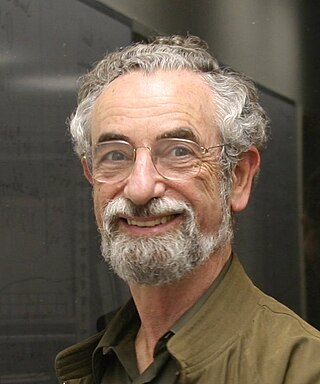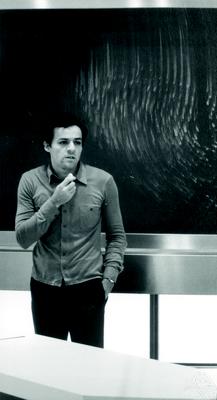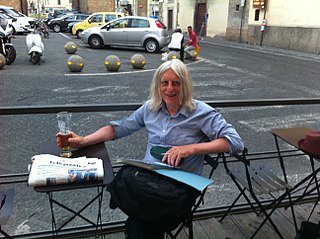Related Research Articles
In physics, statistical mechanics is a mathematical framework that applies statistical methods and probability theory to large assemblies of microscopic entities. It does not assume or postulate any natural laws, but explains the macroscopic behavior of nature from the behavior of such ensembles.

Kenneth Geddes "Ken" Wilson was an American theoretical physicist and a pioneer in leveraging computers for studying particle physics. He was awarded the 1982 Nobel Prize in Physics for his work on phase transitions—illuminating the subtle essence of phenomena like melting ice and emerging magnetism. It was embodied in his fundamental work on the renormalization group.

Erik Peter Verlinde is a Dutch theoretical physicist and string theorist. He is the identical twin brother of physicist Herman Verlinde. The Verlinde formula, which is important in conformal field theory and topological field theory, is named after him. His research deals with string theory, gravity, black holes and cosmology. Currently, he works at the Institute for Theoretical Physics at the University of Amsterdam.

Leo Philip Kadanoff was an American physicist. He was a professor of physics at the University of Chicago and a former president of the American Physical Society (APS). He contributed to the fields of statistical physics, chaos theory, and theoretical condensed matter physics.

In particle physics, the history of quantum field theory starts with its creation by Paul Dirac, when he attempted to quantize the electromagnetic field in the late 1920s. Heisenberg was awarded the 1932 Nobel Prize in Physics "for the creation of quantum mechanics". Major advances in the theory were made in the 1940s and 1950s, leading to the introduction of renormalized quantum electrodynamics (QED). QED was so successful and accurately predictive that efforts were made to apply the same basic concepts for the other forces of nature. By the late 1970s, these efforts successfully utilized gauge theory in the strong nuclear force and weak nuclear force, producing the modern Standard Model of particle physics.

Elliott Hershel Lieb is an American mathematical physicist and professor of mathematics and physics at Princeton University who specializes in statistical mechanics, condensed matter theory, and functional analysis.

David Pierre Ruelle is a Belgian mathematical physicist, naturalized French. He has worked on statistical physics and dynamical systems. With Floris Takens, Ruelle coined the term strange attractor, and developed a new theory of turbulence.

Curtis Gove Callan Jr. is an American theoretical physicist and the James S. McDonnell Distinguished University Professor of Physics at Princeton University. He has conducted research in gauge theory, string theory, instantons, black holes, strong interactions, and many other topics. He was awarded the Sakurai Prize in 2000 and the Dirac Medal in 2004.

Édouard Brézin is a French theoretical physicist. He is professor at Université Paris 6, working at the laboratory for theoretical physics (LPT) of the École Normale Supérieure since 1986.

Giorgio Parisi is an Italian theoretical physicist, whose research has focused on quantum field theory, statistical mechanics and complex systems. His best known contributions are the QCD evolution equations for parton densities, obtained with Guido Altarelli, known as the Altarelli–Parisi or DGLAP equations, the exact solution of the Sherrington–Kirkpatrick model of spin glasses, the Kardar–Parisi–Zhang equation describing dynamic scaling of growing interfaces, and the study of whirling flocks of birds. He was awarded the 2021 Nobel Prize in Physics jointly with Klaus Hasselmann and Syukuro Manabe for groundbreaking contributions to theory of complex systems, in particular "for the discovery of the interplay of disorder and fluctuations in physical systems from atomic to planetary scales".

Giovanni Gallavotti is an Italian mathematical physicist, born in Naples on 29 December 1941.

Jürg Martin Fröhlich is a Swiss mathematician and theoretical physicist. He is best known for introducing rigorous techniques for the analysis of statistical mechanics models, in particular continuous symmetry breaking, and for pioneering the study of topological phases of matter using low-energy effective field theories.
André Neveu is a French physicist working on string theory and quantum field theory who coinvented the Neveu–Schwarz algebra and the Gross–Neveu model.
Jean Zinn-Justin is a French theoretical physicist.
The Ryu–Takayanagi conjecture is a conjecture within holography that posits a quantitative relationship between the entanglement entropy of a conformal field theory and the geometry of an associated anti-de Sitter spacetime. The formula characterizes "holographic screens" in the bulk; that is, it specifies which regions of the bulk geometry are "responsible to particular information in the dual CFT". The conjecture is named after Shinsei Ryu and Tadashi Takayanagi, who jointly published the result in 2006. As a result, the authors were awarded the 2015 New Horizons in Physics Prize for "fundamental ideas about entropy in quantum field theory and quantum gravity". The formula was generalized to a covariant form in 2007.

Hugh Osborn is a British theoretical high-energy physicist and a professor emeritus at the University of Cambridge, Department of Applied Mathematics and Theoretical Physics. He is known for his work on Conformal Field Theory and Quantum Field Theory.
Jean-Bernard Zuber is a French theoretical physicist.

Krzysztof Gawędzki was a Polish mathematical physicist, a graduate of the University of Warsaw and professor at the École normale supérieure de Lyon. He was primarily known for his research on quantum field theory and statistical physics. In 2022, he shared the Dannie Heineman Prize for Mathematical Physics with Antti Kupiainen.

Germán Sierra is a Spanish theoretical physicist, author, and academic. He is Professor of Research at the Institute of Theoretical Physics Autonomous University of Madrid-Spanish National Research Council.
André LeClair is a Canadian-American physicist and academic. He is a Professor at the Cornell University.
References
- ↑ Guggenheim Foundation: Annual Report 1985.
- ↑ "Directory of Fellows and Foreign Members". The Royal Society. Retrieved 12 November 2009.
- ↑ "Recipients of the Dirac medal of the Institute of Physics". Institute of Physics. Retrieved 12 November 2009.
- ↑ "Prize Recipient". American Physical Society. Retrieved 12 November 2009.
- ↑ "Boltzmann Medal". University of Melbourne. Retrieved 8 February 2010.
- ↑ "Dirac Medallists 2011" . Retrieved 10 August 2011.
- ↑ "BREAKTHROUGH PRIZE ANNOUNCES 2024 LAUREATES IN LIFE SCIENCES, FUNDAMENTAL PHYSICS, AND MATHEMATICS". Breakthrough Prize. 14 September 2023. Retrieved 14 September 2023.
{{cite web}}: CS1 maint: url-status (link) - ↑ John L. Cardy (21 February 1992). "Critical Percolation in Finite Geometries". Journal of Physics A: Mathematical and General . 25 (4): L201–L206. arXiv: hep-th/9111026 . Bibcode:1992JPhA...25L.201C. doi:10.1088/0305-4470/25/4/009. S2CID 16037415. arXiv:hep-th/9111026v1.